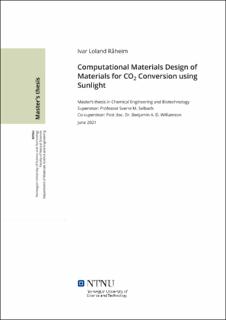| dc.contributor.advisor | Selbach, Sverre M. | |
| dc.contributor.advisor | Williamson, Benjamin A. D. | |
| dc.contributor.author | Råheim, Ivar Loland | |
| dc.date.accessioned | 2021-09-28T18:20:59Z | |
| dc.date.available | 2021-09-28T18:20:59Z | |
| dc.date.issued | 2021 | |
| dc.identifier | no.ntnu:inspera:80233464:14638170 | |
| dc.identifier.uri | https://hdl.handle.net/11250/2785338 | |
| dc.description.abstract | Et stor-skala materialsøk for en halvleder passende for fotokatalytisk CO2-konvertering har blitt gjennomført gjennom et ab-initio beregningsstudie ved hjelp av tetthetsfunksjonalteori (DFT). Materialene som har blitt undersøkt består utelukkende av datagenererte ternære tellurider på formen ABTe2, med A=Li, Na, K, Rb og Cs, og B=Al, Ga og In i forskjellige konfigurasjoner. Prosjektet ble gjennomført som en screeningprosess hvor de forskjellige kandidatene ikke lenger ville bli evaluert dersom de ikke oppfølger forskjellige kriterier nødvendige for god fotokatalytisk ytelse. Den semi-lokale GGA funksjonalen PBEsol ble brukt for gjennomføringen av beregninger av elektronisk struktur og optiske egenskaper. Bidrag fra spinn-bane kobling ble også tatt hensyn til i kalkulasjonene. Prosjektet startet med 28 materialer som allerede hadde blitt evaluert til å være termodynamisk stabile. Blant disse hadde ti kandidater store nok båndgap og lave nok effektive masser for ladningsbærerne til å passere screeningkriteriene. Alle de gjenværende materialene ble så antatt til å være dynamisk stabile basert på fononspredningskalkulasjoner. Tre av kandidatene ble senere screenet ut grunnet lav fotonabsorpsjon for fotoner med energi nære det direkte båndgapnivået. Dermed gjenstår de indirekte absorberende kandidatene Pna21 LiGaTe2 , I-42d LiGaTe2 og C2/c CsGaTe2. Kandidatene med et direkte båndgap som gjenstår er Pna21 LiAlTe2, Pna21 LiInTe2, I-42d LiInTe2 og C2/c CsInTe2. Forbindelsenes A-kation ble analysert til å først og fremst påvirke gitterparametrene, mens B-kationet hadde en stor innvirkning på elektronstrukturen. De mest foretrukne strukturene danner hjørnedelende [BTe4]-tetraeder, hvor både god orbital overlapp mellom s-orbitalene til B-kationet og p-orbitalene til Te leder til god båndspredning, uten at båndgapet blir for smalt. Denne foretrukne tetraederkonfigurasjonen oppstår i strukturene med romgrupper I-42d og Pna21. | |
| dc.description.abstract | A high-throughput computational materials search for a material suitable for photocatalytic CO2-conversion has been completed through an ab-initio study using density functional theory (DFT). The materials that have been investigated includes computer-generated ternary tellurides on the form ABTe2, with A=Li, Na, K, Rb and Cs, and B=Al, Ga and In, in different configurations. The project was carried out in a screening process where requirements important for good photocatalytic performance had to be met in order for the compounds to be further evaluated. The semi-local GGA functional PBEsol was used throughout the project for electronic structure and optical calculations, with included spin-orbit coupling contributions. The project started out with 28 materials that already had been determined to be thermodynamically stable. Out of these, ten had sufficiently large bandgaps and low effective masses to pass the screening criteria. All of these materials were then predicted to be dynamically stable through phonon dispersion calculations. Three of the compounds were later screened out due to low direct absorption of photons with energies close to the direct band gap value. This left us with the indirect absorbers Pna21 LiGaTe2 I-42d LiGaTe2 and C2/c CsGaTe2. The direct candidates that were left are: Pna21 LiAlTe2, Pna21 LiInTe2, I 42d LiInTe2 and C2/c CsInTe2. The A cation was determined to mainly influence the lattice parameters, while the B cation had the largest impact on the electronic structure. The preferred system seems to be B cations in corner-sharing [BTe4] tetrahedra, where both good orbital overlap between B s states and Te p states lea to well dispersed bands without too narrow band gaps. This tetrahedral configuration is found in both the chalcopyritic I -42dspace group and in the orthorhombic Pna21. | |
| dc.language | eng | |
| dc.publisher | NTNU | |
| dc.title | Computational Materials Design of Materials for CO2 Conversion using
Sunlight | |
| dc.type | Master thesis | |
